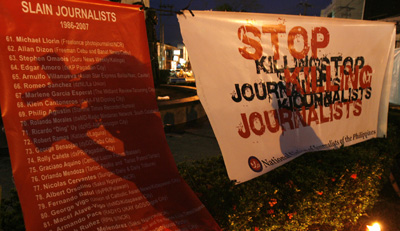Romeo Olea‘s unsolved murder is tragically typical of media killings in the Philippines. Before his death, the radio commentator had received anonymous threats over his reports on local government corruption.
• CPJ’s 2012
Impunity Index
He was later shot and killed by motorcycle-riding assassins who fled the crime scene unidentified. Ten months later, police authorities who initially said Olea’s murder was likely related to his journalism have failed to make any arrests or identify any suspects.
It is a pattern of impunity that has spanned successive Philippine administrations, including the two-year-old government of President Benigno Aquino. At least four journalists, including Olea, have been killed for their reporting on Aquino’s watch. Despite executive vows to turn back the tide of media killings, none of the cases has been solved.
And that figure could be substantially higher: another six reporters have been gunned down under uncertain circumstances since Aquino was elected on a reformist ticket. CPJ continues to investigate whether any of the journalists’ deaths were work-related.
The Aquino-era killings have come against the backdrop of the 2009 Maguindanao massacre, where 32 journalists and media workers were murdered with impunity in the single largest assault against the press ever recorded by CPJ. As with many media murders in the Philippines, the main suspects are politically powerful provincial officials.
Aquino vowed both before and after his election to achieve swift justice in the landmark case. Over two years later the case has bogged down in legal stalling tactics, seemingly aimed at breaking the prosecution’s resolve and resources. The longer the trial drags on, prosecution attorneys involved in the case have said, the greater the chance the main suspects slip free on a technicality.
The persistent failure to achieve convictions in media murders ranks the Philippines third on CPJ’s Impunity Index in 2012, the third year in a row it has placed among the top three countries.
The record of murder and injustice likely influenced Olea’s wife, Raquel, when she asked her spouse to soften his radio commentaries after receiving anonymous threats. He refused to back down, however, and was later murdered for his journalistic integrity. Poignantly in retrospect, Olea’s radio program was known as “Anything Goes.”
In the immediate aftermath of his death, Aquino’s office issued an official message deploring the journalist’s “senseless killing.” But with the assailants behind the crime still free and the Philippines ranking again among the most dangerous places in the world to be a journalist, there is a growing sense that Aquino could and should do more to break the cycle of impunity.
[Reporting from Bangkok]
